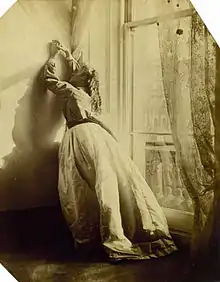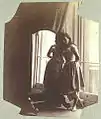Clementina Maude, Viscountess Hawarden
Clementina Maude, Viscountess Hawarden, née Clementina Elphinstone Fleeming (1 June 1822 – 19 January 1865),[1] commonly known as Lady Clementina Hawarden,[2][n 1] was a noted British amateur portrait photographer[3] of the Victorian Era. She produced over 800 photographs mostly of her adolescent daughters.[4][5]
The Right Honourable The Viscountess Hawarden | |
|---|---|
 The Viscountess Hawarden with Donald Cameron of Lochiel, 1861. | |
| Born | Clementina Elphinstone Fleeming 1 June 1822 Dunbartonshire, Scotland |
| Died | 19 January 1865 (aged 42) London, England |
| Nationality | British |
| Occupation | Photographer |
| Spouse(s) | |
| Children | 8 |
| Parent(s) | Charles Elphinstone Fleeming Catalina Paulina Alessandro de Jiménez |
Family
Clementina was one of five children of Admiral Charles Elphinstone Fleeming (1774–1840), and Catalina Paulina Alessandro (1800–1880).[6] In 1845, she married Cornwallis Maude, 4th Viscount Hawarden; the couple had eight children.
Photography
She turned to photography in late 1856 or, probably, in early 1857, whilst living on the family estate in Dundrum, Co. Tipperary, Ireland. A move to London in 1859 allowed her to set up a studio in her elegant home in South Kensington. There she took many of the characteristic portraits for which she is principally remembered. Many include her adolescent daughters Isabella Grace, Clementina and Florence Elizabeth. The furniture and characteristic decor of an upper-class London home was removed in order to create mise-en-scene images and theatrical poses within the first floor of her home. Hawarden produced albumen prints from wet-plate collodion negatives, a method commonly used at the time.[7]
The Viscountess Hawarden first exhibited in the annual exhibition of the Photographic Society of London in January 1863 and was elected a member of the Society the following March. Her work was widely acclaimed for its artistic excellence, winning her the medal for composition at the exhibition.
At a Grand Fête and Bazaar held to raise funds for a new building for the Royal Female School of Art she set up a booth where she photographed guests, the only known occasion on which she took photographs in public.[8] Lewis Carroll, an admirer of her work, brought two children to be photographed at this booth, and purchased the resulting prints.[9]
Her work is often likened to fellow aristocratic photographer Julia Margaret Cameron, although their aesthetics differ widely.
Her photographic years were brief but prolific. Hawarden produced over eight hundred photographs between 1857 and her sudden death in 1864. Lady Hawarden's photographic focus remained on her children. There is only one photograph believed to feature the Viscountess herself, yet it could also be a portrait of her sister Anne Bontine.[4]
A collection of 775 portraits were donated to the Victoria and Albert Museum, London in 1939 by Hawarden's granddaughter, Clementina Tottenham. The photographs were torn, or cut, from family albums. This accounts for the torn or trimmed corners which are now considered a hallmark of Hawarden's work.[4]
Carol Mavor writes extensively about the place of Hawarden's work in the history of Victorian photography. She states, "Hawarden's pictures raise significant issues of gender, motherhood, and sexuality as they relate to photography's inherent attachments to loss, duplication and replication, illusion, fetish."[4]
Gallery
 Hawarden-clem-maude-flo-1863-4
Hawarden-clem-maude-flo-1863-4 Clementina Hawarden, Clementina Maude
Clementina Hawarden, Clementina Maude Hawarden-clementina-maude-1862-3-mirror
Hawarden-clementina-maude-1862-3-mirror Hawarden1
Hawarden1 Clementina Hawarden, Clementina Maude and Isabella, 1861
Clementina Hawarden, Clementina Maude and Isabella, 1861 Lady Clementina Hawarden3
Lady Clementina Hawarden3
Notes
- According to the British peerage she should be referred to as "Clementina, Lady Hawarden", or "Clementina Maude", but today her full styles are rarely used.
References
- "Lady Clementina Hawarden". Victoria and Albert Museum. 2 November 2012. Retrieved 16 May 2019.
- "Lady Clementina Hawarden" at The Pre-Raphaelites Photographs Exhibition Archived February 28, 2014, at the Wayback Machine
- Robinson, H. (2008). Feminism-art-theory: An anthology, 1968–2000. Oxford [u.a.: Blackwell. https://books.google.com/books?id=FHyyliXwGl0C&dq=Feminism-art-theory+:+an+anthology,+1968-2000&hl=en&sa=X&ved=0ahUKEwifzuvq787SAhVi2oMKHcBQD0QQ6AEIJzAC
- Mavor, Carol (1999). Becoming : the photographs of Clementina, Viscountess Hawarden (1st ed.). Durham, NC: Duke University Press. ISBN 9780822323891.
- Crompton, Sarah (6 May 2016). "She takes a good picture: six forgotten female pioneers of photography". London: The Guardian. Retrieved 9 May 2016.
- "The Scottish aristocrat whose pioneering photography drew admiration from Lewis Carroll". The Scotsman.
- Victoria and Albert Museum. (2015). "Lady Clementina Hawarden: Working Methods." Retrieved 2015-03-14.
- Virginia., Dodier (1999). Clementina, Lady Hawarden : studies from life, 1857–1864. Victoria and Albert Museum. (1st ed.). New York: Aperture. p. 89. ISBN 9780893818159. OCLC 41596484.
- Leggatt, Robert. "A History of Photography".
- Virginia Dodier. Clementina, Lady Hawarden: studies from life, 1857–1864. New York: Aperture, 1999. ISBN 0-89381-815-1.
- Graham Ovenden (editor). Clementina Lady Hawarden, 1974 ISBN 0-85670-199-8.
- John Hannavy. Encyclopedia of Nineteenth-century Photography (CRC Press, 2008, ISBN 0-415-97235-3)
| Wikimedia Commons has media related to Lady Clementina Hawarden. |